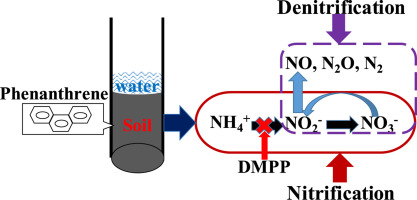Ecotoxicology and Environmental Safety ( IF 6.2 ) Pub Date : 2018-06-14 , DOI: 10.1016/j.ecoenv.2018.06.030 Zhi-Feng Zhou , Ze-Yu Zhang , Ming-Xia Wang , Ya-Min Liu , Jun-Shuai Dai

|
Through a 60-day microcosm incubation, the effect of 3, 4-dimethylpyrazole phosphate (DMPP) on the activities and abundances of ammonia-oxidizers and denitrifiers in phenanthrene-polluted soil was investigated. Five treatments were conducted for clean soil (CK), phenanthrene added (P), phenanthrene and DMPP added (PD), phenanthrene and urea added (PU), and phenanthrene, urea, and DMPP added (PUD) soils. The results indicate that the potential nitrification rate (PNR) in the P treatment was significantly higher than that in the PD treatment only on day 7, whereas the PNR in the PU treatment was significantly higher than that in the PUD treatment on each sampling day. The abundance of soil ammonia-oxidizing bacteria (AOB) in the PU treatment was significantly higher than that in the PUD treatment on each sampling day. Moreover, the abundance of AOB but rather than the ammonia-oxidizing archaea (AOA) had significantly positive correlation with soil PNR (P < 0.05). DMPP showed no obvious effect on the soil denitrification enzyme activity (DEA), which could have inhibited the abundances of denitrification-related narG, nirS, and nirK genes. The results of this study should provide a deeper understanding of the interaction between soil polycyclic aromatic hydrocarbons (PAH) contamination, ammonia oxidization, and denitrification, and offer valuable information for assessing the potential contribution of denitrification for soil PAH elimination.
中文翻译:

硝化抑制剂(3,4-二甲基吡唑磷酸酯)对菲污染水淹土壤中氨-氧化剂和反硝化剂活性和丰度的影响
通过60天的微观温育,研究了3,4-二甲基吡唑磷酸酯(DMPP)对菲污染土壤中氨-氧化剂和反硝化剂活性和丰度的影响。对清洁土壤(CK),添加了菲(P),添加了菲和DMPP(PD),添加了菲和尿素(PU)以及添加了菲,尿素和DMPP(PUD)的土壤进行了五种处理。结果表明,仅在第7天,P处理的潜在硝化率(PNR)显着高于PD处理的硝化率,而PU处理中的PNR显着高于PUD处理的每个采样日。在每个采样日,PU处理中的土壤氨氧化细菌(AOB)的丰度均显着高于PUD处理中的土壤。而且,P <0.05)。DMPP对土壤反硝化酶活性(DEA)没有明显影响,它可能抑制了与反硝化相关的narG,nirS和nirK基因的丰度。这项研究的结果应提供对土壤多环芳烃(PAH)污染,氨氧化和反硝化之间相互作用的更深入了解,并为评估反硝化对土壤多环芳烃消除的潜在贡献提供有价值的信息。











































 京公网安备 11010802027423号
京公网安备 11010802027423号